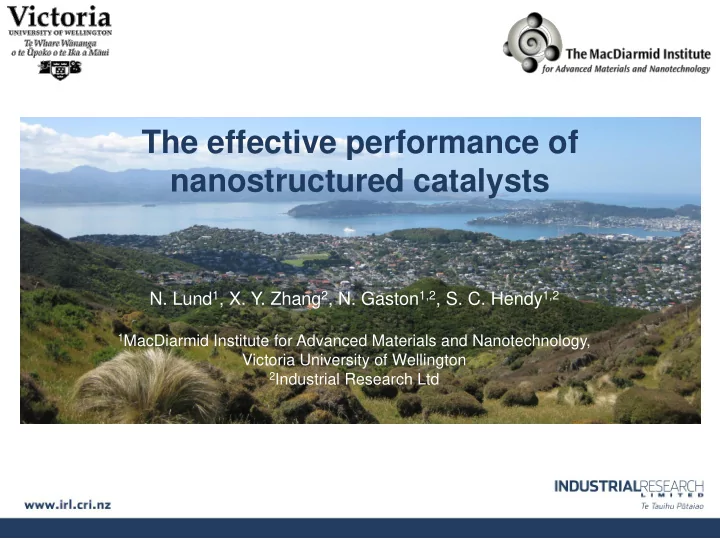

The effective performance of nanostructured catalysts N. Lund 1 , X. Y. Zhang 2 , N. Gaston 1,2 , S. C. Hendy 1,2 1 MacDiarmid Institute for Advanced Materials and Nanotechnology, Victoria University of Wellington 2 Industrial Research Ltd
Precious metal catalysts • Precious metal catalysts are used for many applications e.g. platinum and palladium in catalytic converters CO+1/2 O 2 → CO 2 NO x → x/2 O 2 +1/2 N 2
Nanostructured catalysts • The performance of a catalyst depends on its size & shape Corners and edges tend to be more reactive • How might we determine effective performance so that we can optimise shape and size?
Effective catalysis problem • E.g. oxidation of CO: CO+1/2 O 2 → CO 2 CO CO 2 O 2
Arrays of nanoparticles • Consider an array of nanoparticles on a substrate • How does the effective activity of the particles depend on the arrangement of the particles on the support?
Effective catalysis problem • E.g. oxidation of CO: CO+1/2 O 2 → CO 2 CO CO 2 O 2
Boundary conditions • Gas A to B: 0 A g B g A g B A k terrace L k step A S A probabilit y of absorption k k g i 1 1 A A S k k 0 g i 2 2 A B k k k 3 3 4 B B S k g i 4
Boundary conditions B g area of site a i A g i fractional coverage of site i B A i collision rate of gas A per unit area Q g L In steady state: A d A B d d g g g s k ( 1 ) Q s s 1 i dt dt dt B d k Q g s 1 k i 3 a i (Langmuir eqn) k dt i k Q 3 1 a i
Boundary conditions • Finally obtain a boundary condition: k Q 1 Dn A k Qa 1 1 i k 3 1 8 k T B where according to gas kinetic theory Q A 4 m i • So for (i.e. absorption limited) k Qa k 1 3 k 8 k T 1 B Dn A A 4 m
Boundary conditions D 2 m • Thus in terms of the length b k k T 1 B bn A A k T • But again, gas kinetic theory has B D ~ v ~ g m so b ~ k 1 where is the mean free path of the gas molecule k is a probability of absorption 1
Boundary conditions • So the boundary condition under diffusion limited conditions depends on the length b ~ k 1 A g B g B A b k k L step terrace • Mean free path of gas molecule in air at 1 atmosphere is ~ 100 nm, so b will be of O(100nm)
Mathematical problem • Now we have a diffusion problem with a heterogeneous mixed boundary condition 2 0 in some domain ( x , z ) A : b ( x ) n on z h ( x ) A A / on A 0 b L • Want to replace the heterogeneous condition with a homogeneous b.c. that gives same answer in the far field
Direct solution approach • Use an asymptotic expansion of boundary condition b b b 1 b 2 L L e.g. 2 1 a / L a L b ˆ 1 u z O 0 y ˆ 0 L b eff b b ˆ 2 u z O y 1 ˆ 0 L Hendy and Lund, PRE 76 , 066313 (2007)
Homogenization approach • Use homogenization approach based on weak formulation of Stokes equations: e.g. 2 1 h 1 0 v u dxdz v u dxdz b b 0 as h / W ~ L / W ~ 0 h L Zhang, Lund, Mahelona and SCH, submitted (2011)
Homogenization approach 2 y b 2 sin( ) sin( ) 2 x L L b eff b 1 1 b b eff L / W 0 Zhang, Lund, Mahelona and SCH, submitted (2011)
Recall our results • b ( x ) L Small b and small roughness b eff b h O ( bh ) b ( x ) L • Large b and small roughness 2 1 h 1 b eff b
Effective rate constants • Assume two types of rate constant with k k terrace step spacing on a flat surface L • Case 1: active sites widely space w.r.t. b / k terrace 1 1 k L terrace k eff k k 1 terrace 1 • Case 2: active sites closely space w.r.t. b / k step L k k k eff 1 step k step
Effective rate constants • At atmospheric pressure, a nanostructured catalyst will likely have L k active 2 a so k 1 h k ( 1 ) k eff 1 active where a is the surface roughness • The activity is dominated by the active sites and enhanced by the roughness
Effective rate constants • If however as might occur for an L k active array of particles, then we have h k eff h O ( ) k k 1 1 • Hence, effective activity will depend on the location of the particles h
Effective rate constants 1 • e.g. on a flat support, keeping k 2 sin( 2 x ) L 1 coverage of support by catalyst at 50% Small particles, closely spaced k 1 Big particles, widely spaced L 1 1 k L 1
Conclusions • The macroscopic performance of catalysts depends on the location of active sites and the surface roughness • We have derived some simple expressions that relate the microstructure to the macroscopic performance • Nanostructured catalysts are a good idea but there are diminishing returns! • Roughness can inhibit the performance of arrays of nanoparticles on a substrate
Recommend
More recommend